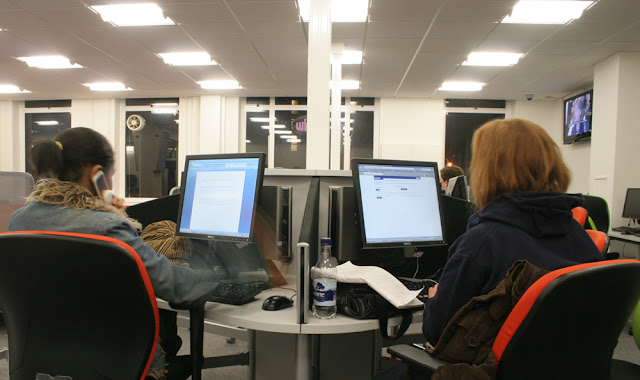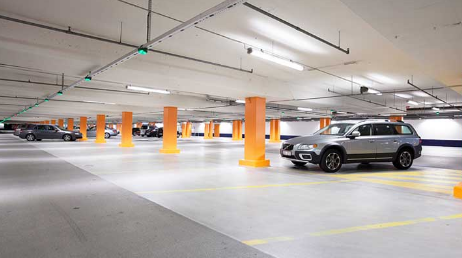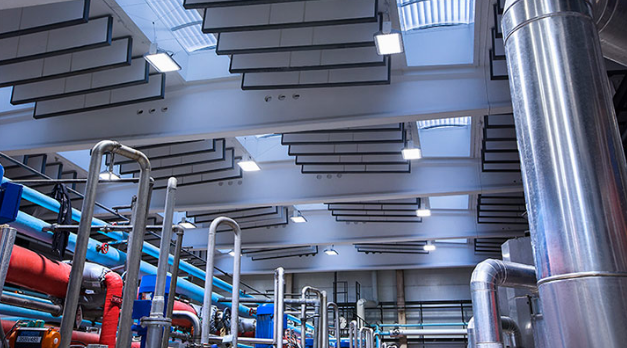Smart traffic lights to ‘communicate’ with drivers to inform them when they are about to change. PLUS: Saudi scientists create ‘fastest li-fi luminaire’. AND: New building standard aims to protect the health of occupants.
intelligent cities · led lighting · led street lights · lifi · lifi traffic lights · Novel Energy Lighting · smart street lights · smart traffic lighting
A THIRD of Britain’s office workers hate their lighting, a study by the respected pollsters Ipsos has discovered.
Some 32 per cent of white-collar employees told the researchers that they were unhappy with the light intensity, with only a fifth were able to alter the light level.
The results are sure to bolster critics of the lit environment in the nation’s commercial workplaces, who have slammed the sector for a lack of creativity. Top lighting designer Paul Nulty, founder of Nulty+, tweeted: ‘Bad lighting effects workplace productivity. Who’d have thought!?’
UK offices still have a preponderance of so-called Category 2 lights – recessed, deeply-louvred fittings designed to minimise reflections on computer screens – which deliver a gloomy environment.
The study of over 12,000 workers across 17 countries showed that the UK workers are the least satisfied with their office ambience. The study appeared to add weight to the argument that local lighting control boosts employee engagement and satisfaction, as the biggest issue was a lack of control. Only 39 per cent of respondents say they can adjust the temperature, while a mere 21 per cent can alter the lighting.
The so-called Category 2 light fixture has long dominated the UK’s offices, but its deep louvres are no longer necessary to prevent reflections on computer screens. Picture: Andrew Malone
‘This could be seriously affecting the concentration, productivity and engagement levels of workers, with the study showing that a lack of flexibility and control over the physical work environment correlates with a lack of engagement’, the study said. In contrast, highly engaged employees are those that have the most flexibility over how and where they work.
The situation in the UK is likely to be influenced by the country’s dominance of open-plan design, with 49 per cent of workers based in this kind of space due to its cost-saving benefits. However, this can limit employees’ individual control over their environment.
Christine Congdon, director of Global Research Communication told Lux: ‘Our research has consistently shown that the most engaged workers are those who have autonomy over how and where they work, whether adjusting the temperature, lighting, or workspace to suit their needs. ‘When people feel like they have choice and control over various aspects of their physical work environment, it leads to greater satisfaction overall.
‘Everybody is different and personal preference will depend on an individual’s natural physiology, their mood on a particular day and the task they are working on. To cater to these constantly changing needs, employers should pay more attention to providing a range of working environments, including the ability to adjust workspace basics as required.’
The study was commissioned by office furniture manufacturer Steelcase.
Visit us at www.novelenergylighting.com to explore our range of office lighting products, including LED panels and LED tubes. Call us to discuss your needs: 0208-540-8287, or drop us an email: sales@novelenergylighting.com
Main picture copyright Ripton Scott 2016
commercial lighting · led panels · led tubes · Novel Energy Lighting · office compliant lighting · office led · office lighting · productivity lighting
Rejuvenating light clinic opens at Harvey Nichols in London. PLUS: LED farm produces 12,000 lettuces a day. AND: GE biosensors monitor athletes at Rio Olympics. Lux Today August 16th 2016.
led exposure · led farm · led for skin · LED lamps · led lighting · lux today · Novel Energy Lighting · Rejuvenating light · vertical farming
19
Car Park LED Lighting Solutions – Philips PacificLED GreenParking
Comments off · Posted by admin in LED, Philips LED
Smart, energy efficient lighting at Globen parking garage with the PacificLED GreenParking system.
Sustainable lighting
The three-floor, 9,000 square meter garage has 1,500 parking places. The original existing lighting installation was divided into 4 zones per floor, each lit with traditional batten luminaires, each housing a 1 x 58W T8 fluorescent tube. When a car entered the garage, the lighting operated at 100% of its full output for two hours, before switching off completely. The lighting quality was poor, and the luminaires were starting to fall apart. When it came to the renovation, Klövern AB didn’t just want to replace the fluorescent lamps with LED lamps. The company wanted something more sustainable. “We’re highly committed to sustainability, so it was very important that we installed a ‘future-proof’ lighting system,” explains Lennard Lindkvist, Energy Manager at Klövern AB.
“We wanted a lighting installation that would produce bright, well-distributed white light, so the garage felt safe and secure for our customers. But at the same time, we wanted a smart, energy-saving system that would help reduce our operating expenses.”
Avoiding cabling costs
Klövern AB wanted to avoid the cost of replacing the cabling, meaning that the new LED luminaires had to be the same length as the existing fluorescent lamp luminaires. “After exploring various options on the market, we decided that the GreenParking system from Philips, which couples Pacific LED waterproof luminaires with wireless control, was the best long-term solution from a sustainability perspective,” continues Lindkvist. “We replaced the luminaires and kept the cabling, which saved significant labor and material costs.”
The complete GreenParking package
GreenParking is an easy-to-install, full lighting system: PacificLED luminaires paired with wireless movement detectors create a complete and controllable wireless lighting system, which enables the luminaires to communicate with each other and behave according to how they are programmed. “For the new lighting installation, the parking garage was divided into 13 zones per floor and more than 120 wireless movement detection sensors were mounted in strategic locations” says Lindkvist. “Unlike with our previous system, we’re only paying for lighting when it’s needed. When a car or pedestrian enters the programmed ‘zone’, the lighting comes on to 90% of its full power. When the car or pedestrian leaves the area, the output drops to 10% after 2 minutes”. “The LED lighting produces a crisp white light – essential for customers to feel safe and secure. And because Pacific LED luminaires are IP65 class rated, we know the luminaires are tough enough to withstand the exhaust gases.”
Halving energy costs
For Klövern AB, it was crucial that the new lighting system saved energy and cut operating costs: “Energy consumption is a major business expense for us – but also one we can address by investing in new technology. With every penny we save on energy, the property becomes more profitable”. “We’ve cut energy consumption by more than 50%. The LED luminaires account for 75% of the energy savings, the lighting controls 25%. “We’ve saved 350,000 kWh per year by switching to the Philips GreenParking system. In fact, we save as much energy as 17 houses consume every year.” The long life span of the LED luminaires means Klövern AB will also reduce its maintenance costs: “With the old system, we had to replace the fluorescent lamps every other year. The new LED modules won’t need replacing for 15 years. This not only saves time and money – it makes us a more environmentally friendly company as well.”
Contact us at www.novelenergylighting.com, T: 0208-540-8287, E: sales@novelenergylighting.com to discuss LED retrofit options for your car parking or outdoor lighting facilities.
car park lighting · led lighting · Novel Energy Lighting · philips car park lighting · philips greenparking · philips led · philips pacific · philips pacificled
New technology gives diners ability to choose a lighting mood to suit their meal. PLUS: Light pollution robs Americans of a night sky view. AND: LED used to battle elephants in India. Lux Today August 2nd 2016.
hospitality led · hospitality lighting · led lighting · light pollution · mood lighting · Novel Energy Lighting · restaurant lighting
8
Two-minute explainer: Lighting for the partially sighted
Comments off · Posted by admin in LED
 |
| Lighting can do a lot to assist partially sighted people. |
The Equality Act 2010 is intended to protect partially sighted people from unfair treatment in employment and when accessing public services. But what more can be done with light to make life a little more equable for those with disabilities? In particular, how can light be best utilised to benefit partially sighted people?
Colour Contrast
- Use colour to highlight differences between objects and surfaces, making it easier to negotiate a complex space. For example, in a white-tiled bathroom have the bathroom furniture in a different colour.
- Use different colours to highlight circulation routes from functional space (retail spaces, open-plan offices etc).
- Paint door frames a different colour to the doors and walls.
- Consider a different colour for door handles.
- Ensure that railings on stairs are a different colour to the walls, likewise the banisters.
- It is important to be able to pick out the edge of steps so use a contrasting strip or nosing.
- Glass doors and windows need to be visible, so consider the use of brightly coloured designs where vertical glazing is accessible to passers-by.
Lighting
- Increase light levels in areas such as stairs and level changes in areas like the kitchen and the bathrooms. There may be an aesthetic challenge in achieving this, but new low-energy LED sources can deliver high light levels from relatively small fixtures.
- Introduce additional light fixtures in areas where spatial definition is important.
- Make sure that light is in the places where it needs to be. Use the efficiency of localised lighting to assist in visual tasks, especially in places like kitchens and at work stations.
- Make the best use of natural light, but be aware of the potential problems that an over-bright blind can cause by ‘bleaching’ the rest of the surroundings.
- Make sure that any exterior lighting acts as a ‘way-marker’ as well as providing illumination. A line of light points can be more helpful than an illuminated pathway.
- Use light as a defining element in areas of the building where there are objects or furniture that protrude into circulation routes.
- Consider the impact of emergency lighting should the normal electrical supply fail. Escape lighting should assist in finding the route to safety for everyone.
The Equality Act 2010 requires employers to provide individual lighting provision to any employee requiring it.
Anyone registered as blind or partially-sighted automatically meets the Equality Act’s definition of a disabled person. Anyone with a sight loss that has a ‘substantial and long-term effect on your ability to carry out normal day-to-day activities’ may qualify for registration. In these circumstances, the requirements of the Equality Act 2010 must be met.
Credit: John Bullock, Lux
equality act 2010 · led lighting · led panels · lighting for partially sighted · Novel Energy Lighting · office lighting · partially sighted
5
Philips: 3 Factories 5 Star Lighting Solutions (Novozymes, Denmark – Case Study)
Comments off · Posted by admin in LED, Philips LED
Philips GreenManufacturing system has been installed in three production units. The functionality of the system can be adapted to individual areas based on behavioural patterns and the requirements of the people working there.
Project and requirements
Novozymes has three factories in which a large number of T8 neon tube light fittings needed replacing. Access conditions at all three locations were generally difficult, making a traditional cable-based installation very time consuming. The plan therefore called for reuse of the existing cable installation, coupled with an intelligent solution to be able to control lighting levels as needed and based on human presence. The aim was also to reduce electricity consumption and contribute to sustainable production. Furthermore, the two installation contractors, Lindpro and Electricom, had only four months from signing the contract to completing the work. “The installation process had to be flexible enough to give us the opportunity to optimise if modifications were made to the premises”, explains Peter FinkJensen, Senior Project Manager at Novozymes. Philips’ GreenManufacturing is a new lighting system based on LED fittings with integrated lighting control and wireless sensors. Acting upon the recommendation of consultant Sweco, GreenManufacturing was selected, as it met all of the requirements.
Requirements met by GreenManufacturing
The GreenManufacturing system has been installed in all three production units. Replacement was on a 1:1 basis, reusing the existing cables. A total of 4,400 Pacific and GentleSpace LED fittings were installed, plus 1,200 sensors able to communicate wirelessly with these fittings. No further installation work was needed, as the wireless sensors can be relocated when required. GreenManufacturing functionality can be adapted to individual areas based on behavioural patterns and the requirements of the people working there.
When no movement is detected after ten minutes, the light dims to 10%, and in designated areas switches off after a further ten minutes. “Our energy savings have been calculated to be around 4,600 MWh per annum. No replacement of tubes will be required during the lifetime of the fittings, which also saves us maintenance costs and, of course, disruption for production and the workforce,” says Peter Fink-Jensen. “Service life is expected to be around 15 years for 9-10 hours daily use,” explains Andreas Birch from Sweco, consultants for the project. “Credibility, quality products and a well-known manufacturer with a good track record that is able to provide the necessary support were the reasons we chose Philips”, adds Fink-Jensen.
“The project ran to plan, and the GreenManufacturing solution was installed at all three production facilities, four months after the contract was signed. Production runs around the clock and stayed uninterrupted throughout the entire project”, he stated.
Satisfied users
“We are very satisfied with the lighting. Large factory buildings like ours can be uncomfortable to be in if they seem dark, but the lights come on so quickly that it doesn’t feel insecure. The light intensity is also higher than from the old tubes”, claims Peter Kolby, an operator at the site. “The fact that the lights do not turn off completely is nice. By keeping them on at 10% means we can still see in the building, something that is necessary, not least from a safety point of view. When we work on the night shift, it’s really great to have full lighting throughout.”
Easy and fast installation
“Electricom was responsible for about half of the installation. Per Junge, installer and owner, is very satisfied with GreenManufacturing and the level of support provided by Phillips:
“Philips gave us thorough instructions to commission the system, and our electricians have nothing but good things to say about it”, he says, pointing out that GreenManufacturing system will definitely be used again in the future. “With the intelligent GreenManufacturing solution there was no need for new cables, which made it all very easy to install. I have already proposed the same solution to other customers”, says Service Leader Martin Fehrn from Lindpro. “The aim was to cut electricity consumption and contribute to sustainable production – and we certainly succeeded with GreenManufacturing”, says Fink-Jensen, Senior Project Manager at Novozymes and responsible for running the project.
Visit www.novelenergylighting.com to explore the Philips LED High Bay range, including Philips Coreline Highbay, and Philips Gentlespace LED. Tel: 0208-540-8287
factory lighting · led higbay · led high bay · led highbay · Novel Energy Lighting · philips coreline highbay · philips gentlespace · philips led · warehouse lighting
 |
Elephants are causing serious headaches for farmers in India. |
 |
| Elephants have now started coming out of the forest throughout the year instead of only during harvest seasons. |
LED lighting is being inventively utilised in East India to prevent rampaging elephants from trampling farmer’s crops.
For months farmers in Odisha have been battling to prevent elephants from raiding vegetables, fruits and paddy. Miles of trenches and solar fencing have all failed to prevent the incursions, but now a newly installed low cost lighting system is showing signs of success.
Flashing LED lights suspended on bamboo poles have been installed at sixty metre intervals across forty-five acres of crops. The lights were placed so they would be at the elephant’s eye level, while being visible from a long distance.
Despite the fields being full of tomatoes, pumpkins and bananas, the elephants have opted to keep their distance from the illuminated crops.
‘The light system has been designed based on our field experience with elephants and their habits,’ Biswajit Mohanty, project director at the Wildlife Protection Society of India (WPSI) told The Hindu newspaper.
‘We knew that the elephants would be scared of flashing lights instead of fixed and powerful lights. We developed this design using low power LED bulbs used as strobes.’
The LED system was also used during the lucrative Indian mango season, which runs from April to June.
Hopefully the lights will be popular with farmers so that they can sleep peacefully instead of chasing elephants all night.
Biswajit Mohanty – The Wildlife Protection Society of India
‘I used to incur huge losses due to elephant herds entering my orchards and attacking mango trees,’ Odisha farmer Jugal Kishore Nayak told The Hindu. ‘But this year, the lighting system has kept the elephants at bay.’
The WPSI now plans to develop a prototype self-contained lighting unit, with an in-built solar charger, which will make the fixtures easier to maintain.
‘Hopefully the lights will be popular with farmers so that they can sleep peacefully instead of chasing elephants all night,’ Biswajit Mohanty concluded.
The Indian farmer’s elephant problem is much more serious than a few ravenous mammals stealing fruit and vegetables. Odisha has lost more than 700 elephants and 700 people during man-elephant conflicts since 2004. During the same period, elephants trampled ready-to-harvest crops across 90,000 acres of land.
The experiment assumes extra significance as elephants have now started coming out of the forest throughout the year instead of only during harvest seasons.
Visit www.novelenergylighting.com to purchase you elephant deterrent lighting today, or call Andy on 0208-540-8287 to discuss pachyderm prevention measures!
elephant deterrent · elephants · led in india · LED lamps · led lighting · led panels · led tubes · Novel Energy Lighting · pachyderm prevention
Amazon granted patent to develop drone docking stations that sit on street lights. PLUS: Poor lighting prompts concern before opening of Rio Olympics. AND: Top US basketball team announces li-fi first for new stadium. Lux Today August 2nd 2016.
amazon drone · led lighting · li-fi · lifi · lux review · Novel Energy Lighting · rio lighting · stadium lighting
1
Light Generates Added Value, More Effect, More Turnover, More Efficiency
Comments off · Posted by admin in LED, LED downlights, LED Spots
Retail is dependent on turnover. And, of course, profit, in the end. Whether it be food or non-food – the level of financial success is largely dependent on the type of lighting. And in a quite different way.
Light inspires, light stimulates, light seduces
The correct lighting puts the customers in a buying mood. This starts in the shop window: Effective lighting causes people to pause in fascination. In the sales area the light takes on several roles: from simple orientation, via accenting the products to the staging of the entire indoor area. The right light is pure sales promotion – in retail, in shopping malls and in warehouses. Lighting creates atmosphere, puts products in the right light, supports customer guiding and emphasises the brand image.
Clear potential saving by efficient light
In retail, lighting represents a considerable cost factor: in the food trade, this is 25 % of the total energy costs. In the non food trade, lighting represents more than 60 % of the energy costs and is the highest cost factor! This is often combined with high maintenance costs. Using modern light and well thought out lighting solutions, individually adapted to the individual shop scenario, you can realise significant potential saving.
Modern durable lighting solutions from the OSRAM Group
Three brands – one aim: perfect lighting. For every situation. Together with its subsidiaries Siteco and Traxon, OSRAM offers high quality flexible and pioneering lighting solutions and products. The portfolios supplement each other perfectly in shop lighting. The result: innovative, decorative and attractive light, enormously versatile and variable, highly efficient and thereby cost-reducing. From precise point accent lighting and homogeneous general lighting, via pioneering lighting control systems, to dynamic LED effect lighting.
Visit www.novelenergylighting.com today to explore what Osram can do for you. We can provide light plans and project quotations for your LED retrofit project. Tel: 0208-540-8287
food led · Novel Energy Lighting · osram led · osram lighting · retail led · retail lighting · shop lighting








